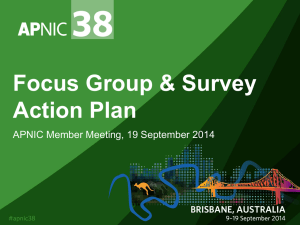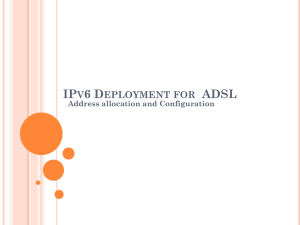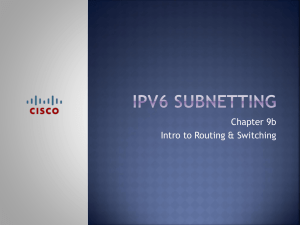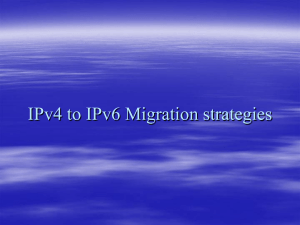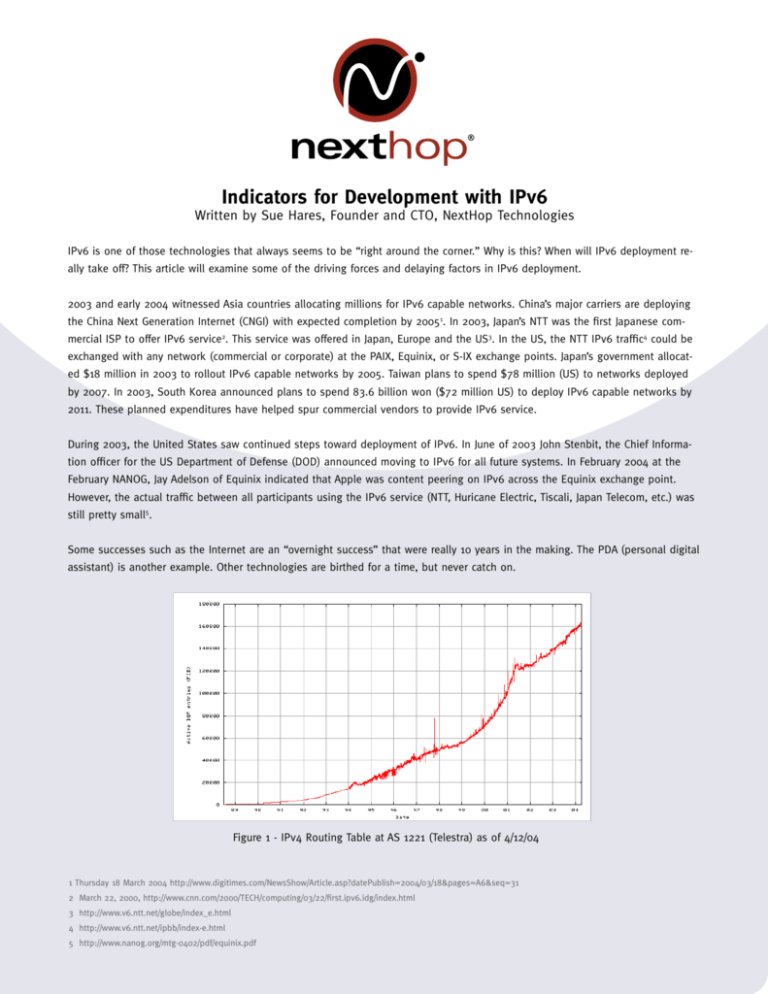
Indicators for Development with IPv6
Written by Sue Hares, Founder and CTO, NextHop Technologies
IPv6 is one of those technologies that always seems to be “right around the corner.” Why is this? When will IPv6 deployment really take off? This article will examine some of the driving forces and delaying factors in IPv6 deployment.
2003 and early 2004 witnessed Asia countries allocating millions for IPv6 capable networks. China’s major carriers are deploying
the China Next Generation Internet (CNGI) with expected completion by 20051. In 2003, Japan’s NTT was the first Japanese commercial ISP to offer IPv6 service2. This service was offered in Japan, Europe and the US3. In the US, the NTT IPv6 traffic4 could be
exchanged with any network (commercial or corporate) at the PAIX, Equinix, or S-IX exchange points. Japan’s government allocated $18 million in 2003 to rollout IPv6 capable networks by 2005. Taiwan plans to spend $78 million (US) to networks deployed
by 2007. In 2003, South Korea announced plans to spend 83.6 billion won ($72 million US) to deploy IPv6 capable networks by
2011. These planned expenditures have helped spur commercial vendors to provide IPv6 service.
During 2003, the United States saw continued steps toward deployment of IPv6. In June of 2003 John Stenbit, the Chief Information officer for the US Department of Defense (DOD) announced moving to IPv6 for all future systems. In February 2004 at the
February NANOG, Jay Adelson of Equinix indicated that Apple was content peering on IPv6 across the Equinix exchange point.
However, the actual traffic between all participants using the IPv6 service (NTT, Huricane Electric, Tiscali, Japan Telecom, etc.) was
still pretty small5.
Some successes such as the Internet are an “overnight success” that were really 10 years in the making. The PDA (personal digital
assistant) is another example. Other technologies are birthed for a time, but never catch on.
Figure 1 - IPv4 Routing Table at AS 1221 (Telestra) as of 4/12/04
1 Thursday 18 March 2004 http://www.digitimes.com/NewsShow/Article.asp?datePublish=2004/03/18&pages=A6&seq=31
2 March 22, 2000, http://www.cnn.com/2000/TECH/computing/03/22/first.ipv6.idg/index.html
3 http://www.v6.ntt.net/globe/index_e.html
4 http://www.v6.ntt.net/ipbb/index-e.html
5 http://www.nanog.org/mtg-0402/pdf/equinix.pdf
Will IPv6 be a latent overnight success or will it just never catch on?
To answer this, we’ll examine the needs that IPv6 was chartered to solve, costs of adoption of IP v6 and what forces are impacting the adoption of IPv6 in the market place:
- Forces that are steadily driving IPv6 deployment,
Chart 1 - Embedded OS Support7
- Forces that are impeding IPv6 growth,
OS
Product
Year
- Forces that may spur “overnight success” or more rapid adoption
6Wind
(WindRiver)
VxWorks
2002
In the last five years, IPv6 technology has steadily crept into the market place. In some
Elmic
Turb Treck
2002
parts of the world such as Asia, the pace of adoption is faster. Yet at the same time, the
Interpeak
VxWorks, OSE,
Nucleus
2001
KAME
freebsd, netbsd,
openbsd
1998
Linux
Linux
2000
barriers to IPv6 adoption loom higher in 2004 than in 1995 when it was first chartered.
Getting IPv6 to wide usage
Forces that drive steadily for IPv6
IPv6 has been under development since 19946.
Early developer packages for IPv6 were available
in 1995 on PCs or workstations. So, why has it
taken so long to be adopted?
Chart 2 - IPv6 support in GateD OEM (www.nexthop.com)
Routing
Software
RIPng
MPBGP
v6
ISIS
v6
OSPF
v3
MPLS
Static
L3 VPN LDP label to
v6
IPv6
RSVP-TE
NextHop
GateD
1999
2000
2000
2003
2003
2004
2003
2003
To deploy IPv6, the technology needs to go
from developer packages to products (hosts, routers, firewalls, mobile phones), and from products into real networks. To get
widespread products, you must have the chip sets, operating systems, and routing software that support IPv6 addresses at high
performance levels.
Chips go may go through 1 or 2 revisions refine the costs or power requirements. In the early days of IPv6 deployment, processing of packets to be forwarded was done in software. In 2002-2003, several NPU and chip manufacturers have announced support for IPv6 in the forwarding path including: Intel, IBM, Agere, and PMC Sierra8. This is a critical step in ensuring that adoption
of IPv6 will not degrade performance from IPv4 performance levels.
Similarly, most network equipment manufacturers do not actually write their own routing software or embedded OS. Chart 2
shows the availability of IPv6 support in OS. Chart 2 shows the available of OEM
The first wave of host (usually server) products with IPv6 was shipped in 1998 by BSDi, Hitachi, freeBSD, and SCO. Sun shipped
both IPv4 and IPv6 in Solaris 8 in 2000. Microsoft shipped IP v6 in Microsoft Windows 2002. As chart 1 shows, the release of
host products with IPv6 support has been growing steadily from 1998 to the present.
6 1st revision of RFC 1726 was done in 1994 (http://playground.sun.com/pub/ipng/html/ipng-main.html)
7 Embedded OS deployment are based off of playground.sun.com/pub/ipng/html/ipng-implementations.html plus references to: elmic (http://www.elmic.com/news_rel.
html#dualmode), KAME (www.kame.net), linux (http://www.linux-ipv6.org/~sekiya/IETF49, OpenBSD (www.openbsd.net)
8 Intel’s support of IPv6: www.intel.com/update/departments/initech/it03022.pdf
IBM’s ASO - http://www-3.ibm.com/chips/products/wired/products/software.html
Agere Payload Plus- http://www.agere.com/NEWS/PRESS2002/050602a.html
PMC Sierra:http://www.pmc-sierra.com/products/details/pm2329/index.html#Applications
The first wave of router products8 that supported IPv6
only supported RIPng. These came out in 1997. These ear-
Chart 3 - Routers9
Router
RIPng
BGPv6
ISISv6
OSPFv3
PIMSMv6
PIMSSMv6
v6 on
MPLS
Cisco 12.3,
12.2, 12.0
2001
2001
2001
2002
2003
2003
2002
ISISv6, and MP-BGPv6) and MPLS protocols.
Extreme
Networks
2002
2002
Foundary
- BigIron
2002
2002
2003
2002
Chart 4 shows how IPv6 implementations in firewalls have
Hitachi
(GR2000)
19982000
2000
2001
2001
2001
2001
2001
Juniper
(JUNOS)
2001
5.1
2001
5.1
2001
5.1
2002
5.3
2003
5.6
2003
5.6,
6.0
2003
5.1
ly IPv6 routers included 3COM, Ericsson Telebit, Hitachi’s
GR2000, Nortel Baystack, and Sumitomo’s Suminet 3700.
By 2004, most of router manufacturers have commercial
products with multiple IPv6 routing protocols (e.g. RIPng,
lagged, but are catching up quickly. In August of 2002,
Checkpoint announced it would support IPv6 filtering in
the Checkpoint Firewall 1. In 2003, Netscreen and Nokia
followed with Beta versions in their software. In 2004,
Checkpoint demonstrated firewall filtering plus routing in
the Moonv6 trials.
Chart 4 - IPv6 Capable Firewalls10
Firewalls
IPv6
Filters
IPv6
Routing
Checkpoint
2002
2004
Moonv6
solve: IPv4 address exhaustion and security. In early 1997 wide spread deployment of
Cisco PIX
2Q 2004
IPv6 solutions (to solve address exhaustion problems) looked to be 2 years away. Due to
Netscreen
2003
(beta)
Nokia
2003
(beta)
Forces that Impede IPv6 growth
1
The deployment of NAT11 devices and VPNs have slowed or impeded the growth of IPv6.
NAT and VPN technology work around two of the problems that IPv6 was chartered to
urgent needs to slow down route growth, a NAT solution was deployed as an interim fix.
VPNs were also deployed as an interim fix to glue private networks together. These solutions (NATs and VPNs) alleviated pressure on the IPv4 address problems.
SonicWall
Watchguard
2 IPv6 requires the deployment of IPv6 network infrastructure: routers, firewalls, DNS serv-
2Q 2004
(pilot)
ers, network management devices. IPv6 also requires that networks retrain their network
operations staff. In 2003, telecommunication network operators are reducing staff and curtailing capital investments. Deploying IPv6 infrastructure is thus unlikely unless it leads to new revenue.
9 IPv6 routers:
http://playground.sun.com/pub/ipng/html/ipng-implementations.html with additional references to:
Cisco: 12.0 and 12.2 releases
http://www.cisco.com/ipv6
http://www.cisco.com/univercd/cc/td/doc/product/
software/ios122/122newft/122t/122t13/ipv6/ftipv6s.htm
Juniper: releases 5.1-5.6
www.juniper.net/news/pressreleases/2001/pr-011128.html
www.juniper.net/techpubs/software/junos51/swconfig51-ipv6/html/
www.juniper.net/techpubs/software/junos/junos56/rn-sw-56/html/rn-sw-56.html
Hitachi:
2000 release: http://global.hitachi.com/New/cnews/E/2000/001129B.html
10 http://playground.sun.com/pub/ipng/html/ipng-implementations.html with additional references to:
DecAlpha with Compaq VMS and True-64 IP v6
http://www.ipv6forum.com/navbar/press/pressroom.htm
http://h18000.www1.hp.com/ipv6/OpenVMSTimesCustJan-Mar2001.pdf
Solaris 8 with IPv6: http://wwws.sun.com/software/solaris/ipv6/
Forces that may quickly drive toward IPv6 globally or locally
Four types of forces may cause IPv6 to go from rolling slowly toward a success to an instant success:
1 Changes in the rate of IPv4 address usage
2 Niche market explosion
3 Geographical market explosion
4 Killer applications
A Niche market explosion could come from cell phones. If the Chinese network deployments promised in 2005 occur, it will spur
additional deployments. Killer applications that can only be practical on IPv6 may be developed in locations that have a rich IPv6
infrastructure. The World Wide Web came out of a research effort to utilize the Internet to publish information. Research institutions in Japan associated with WIDE are helping IPv6 provide classrooms over the Internet, IPv6 Mobility, IPv6 over satellites, and
IPv6/label switching support. One application, InternetCar1817, got IPv6 networks working to over 2000 vehicles in the Tokyo metropolitan area to track weather patterns and traffic patterns. Since traffic jams in metropolitan areas may occur in areas with lots
of rain, the vehicles (many were taxi’s) were networked to provide instantaneous local information on weather patterns.
Key Indicators to watch
- Changes in the rate of IPv4 address usage
(routes: bgp.potaroo.net, addresses allocations: www.arin.net)
- Changes in the rate of IPv6 address assignment and usage
(routes: bgp.potaroo.net, addresses: www.apnic.net (reports and stats)
- Changes in IPv6 products shipped
- Increased frustration with NAT or VPN limits or complex configuration
- Technological IPv6 markets such as cell phones or IP mobility growing dramatically
- Geographical markets with IPv6 focus in Asian (this includes China, Japan, India, Korea, and Malaysia),
- Killer applications built on IPv6
11 Firewalls:
Checkpoint: http://www.checkpoint.com/press/2002/ipv6_081402.html
Netscreen: http://www.netscreen.com/company/news_room/ns_news article on
7/23/2003: Netscreen puts IPv6 in firewall Beta
Nokia: http://www.internet-security.at/p/nokiaip/IP530_PB.PDF
NextHop Technologies, Inc. is the definitive source for network routing software solutions. NextHop’s flagship product, GateD NGC, the de facto standard, is the most
widely used vendor-neutral routing software in the world. NextHop partners with its customers and the industry to empower innovation in networking with safe and
reliable products that reduce time to market while minimizing development, testing and support costs. Founded in 2000 and funded by New Enterprise Associates,
Labrador Ventures, and Parker Price Venture Capital, NextHop is based in Mountain View, Calif. Visit NextHop on the Web at www.nexthop.com.
NextHop and GateD are registered trademarks of NextHop Technologies, Inc.
Copyright © 2005 NextHop Technologies, Inc. All rights reserved.
CORP-US-SWP1-S-01032005

